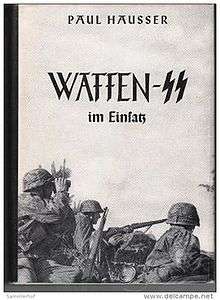Waffen-SS im Einsatz
 | |
| Author | Paul Hausser |
|---|---|
| Original title | Waffen-SS im Einsatz |
| Country | West Germany |
| Language | German |
| Genre | War story; Historical revisionism |
| Publisher | Plesse Verlag |
Publication date | 1953 |
| Media type | |
| Followed by | Soldiers Like Any Other |
Waffen-SS im Einsatz (Waffen-SS in Action) is a 1953 book in German by Paul Hausser, a former high-ranking Waffen-SS member and a leader of the Waffen-SS lobby group HIAG. As part of the organisation's revisionist agenda, it advanced the idea of the purely military role of the Waffen-SS.[1]
The first major work by one of the HIAG leaders, it was published by Plesse Verlag, owned by a right-wing politician and publisher Waldemar Schütz. Hausser's book, along with those by other key HIAG members Felix Steiner and Kurt Meyer, has been characterised by the historian Charles Sydnor as one of the "most important works of [Waffen-SS] apologist literature."[2]
Background
From 1950, Hausser was active in HIAG, a revisionist organization and a lobby group of former Waffen-SS members. HIAG began in late 1950 as a loose association of local groups; by October 1951, it claimed to have 376 local branches. In December 1951, Hausser became its first spokesperson.[3]
As part of its lobbying efforts, HIAG attempted to advance the idea of the Waffen-SS being the "fourth branch of the Wehrmacht" and in no way connected to the crimes of the regime.[4] HIAG's rewriting of history included significant multi-prong propaganda efforts, including tendentious periodicals, books and public speeches, along with a publishing house – Munin Verlag – to serve as a platform for its publicity aims. The express aim of Munin Verlag was to publish the "war narratives" of former Waffen-SS members, in cooperation with HIAG.[5][6]
Contents
British military historian Keith Simpson in his book Waffen SS quotes Hausser for writing that, he "hoped the work would disperse the lies and calumnies which had formed themselves around the Waffen-SS and help to give this courageous formation its place."[7] The book had an unmistakable connection to the Nazi origins of the Waffen-SS: the SS runes on the cover art and the SS motto ("my honor is my loyalty") embossed on the cloth cover. A foreword from the former Wehrmacht general Hans Guderian provided an endorsement for the Waffen-SS troops and referred to them as "the first realization of the European idea".[8]
The book described the growth of Waffen-SS into a so-called multinational force where foreign volunteers fought heroically as a "militant example of the great European idea".[8] Historians have refuted this characterisation, arguing that it was largely Nazi propaganda employed to bolster the ranks of the Waffen-SS with foreign volunteers. The message was later repurposed by HIAG as it sought historical and legal rehabilitation of the force.[8]
Hausser wrote another book, published in 1966 by HIAG's imprint Munin Verlag, under the title Soldaten wie andere auch ("Soldiers Like Any Other"). According to the military historian S.P. MacKenzie, the work epitomised how HIAG leaders wanted the Waffen-SS to be remembered, while the historian Charles Sydnor described it as "equally tendentious".[9][10]
Reception
Waffen-SS in Action was included in the index of objectionable war books maintained by West Germany's Federal Department for Media Harmful to Young Persons. The index was created in the early 1960s to limit the sale of such works to minors due to their chauvinism and glorification of violence.[11]
Hausser's books, along with those by other key HIAG members and former Waffen-SS generals Felix Steiner and Kurt Meyer, have been characterised by the historian Charles Sydnor as the "most important works of [Waffen-SS] apologist literature." These works demanded rehabilitation of the military branch of the Nazi Party and presented Waffen-SS members as both victims and misunderstood heroes.[2]
See also
References
Citations
- ↑ Simpson 1990.
- 1 2 Sydnor 1990, p. 319.
- ↑ Large 1987, pp. 82–83.
- ↑ Large 1987, p. 81.
- ↑ Wilke 2011, p. 399.
- ↑ MacKenzie 1997, p. 138.
- ↑ Simpson 1990, p. 6.
- 1 2 3 MacKenzie 1997, pp. 137–138.
- ↑ MacKenzie 1997, p. 137.
- ↑ Sydnor 1973.
- ↑ Tauber Volume I 1967, p. 539.
Bibliography
- Diehl, James M. (1993). Thanks of the Fatherland: German Veterans After the Second World War. University of North Carolina Press. ISBN 978-0-8078-2077-3.
- Kienle, Polly (2005). "Still Fighting for the Myth: German Wehrmacht Officers' Reports for the U.S. Historical Division". H-net.com. Archived from the original on 28 January 2016.
- Large, David Clay (1987). "Reckoning Without the Past: The HIAG of the Waffen-SS and the Politics of Rehabilitation in the Bonn Republic, 1950–1961". The Journal of Modern History. University of Chicago Press. 59 (1): 79–113. doi:10.1086/243161. JSTOR 1880378.
- MacKenzie, S.P. (1997). Revolutionary Armies in the Modern Era: A Revisionist Approach. Routledge. ISBN 978-0-415-09690-4.
- Picaper, Jean-Paul (2014). Les Ombres d'Oradour: 10 Juin 1944 [The Shadows of Oradour: 10 June 1944] (in French). Paris: Éditions l'Archipel. ISBN 978-2-8098-1467-5.
- Simpson, Keith (1990). Waffen SS. Gallery Books. ISBN 978-0-8317-2673-7.
- Stein, George (1984) [1966]. The Waffen-SS: Hitler's Elite Guard at War 1939–1945. Ithaca, N.Y.: Cornell University Press. ISBN 978-0-8014-9275-4.
- Sydnor, Charles W. (1990) [1977]. Soldiers of Destruction: The SS Death's Head Division, 1933–1945. Princeton University Press. ISBN 978-0-691-00853-0.
- Sydnor, Charles W. (1973). "The History of the SS Totenkopfdivision and the Postwar Mythology of the Waffen SS". Central European History. Cambridge University Press. 6 (4): 339–362. doi:10.1017/S0008938900000960.
- Tauber, Kurt (1967). Beyond Eagle and Swastika: German Nationalism Since 1945, Volume I. Middletown, Conn.: Wesleyan University Press.
- Wienand, Christiane (2015). Returning Memories: Former Prisoners of War in Divided and Reunited Germany. Rochester, NY: Boydell & Brewer. ISBN 978-1-57113-904-7. JSTOR 10.7722/j.ctt13wzt4c.
- Wilke, Karsten (2011). Die "Hilfsgemeinschaft auf Gegenseitigkeit" (HIAG) 1950–1990: Veteranen der Waffen-SS in der Bundesrepublik [HIAG 1950–1990: Waffen-SS veterans in the Federal Republic] (in German). Paderborn: Schoeningh Ferdinand GmbH. ISBN 978-3-506-77235-0.